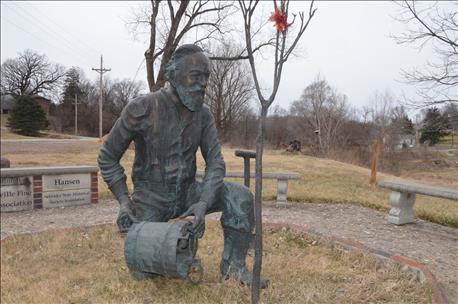
It's a rare thing when an ag journalist get the opportunity to see a museum exhibit devoted to their publication and its founder. Last week, I had that opportunity when I visited Brownville – a small town of less than 200 situated in the bluffs along the Missouri River in southeast Nebraska.
The Brownville Historical Society is currently undertaking a renovation project to restore the town's historic Ford Garage – what is also called the Wheel Museum, one of several renovation projects involved with the historical society's "Preserving Our Past/Protecting Our Future" campaign.

AGRICULTURAL ROOTS: This sculpture of Robert W. Furnas made by sculptor Tom Palmerton sits in Brownville's Furnas Arboretum.
When renovations are completed, the Wheel Museum will house a vast array of artifacts from the 1800s, a number of them relating to agriculture, including an exhibit devoted to Robert W. Furnas, a farmer, soldier, postmaster, and tinsmith who first began publishing Nebraska Farmer in Brownville back in 1859.
Originally from a farm in Ohio, Furnas brought much more with him than the state's first agricultural publication when he stepped off the ferry on the banks of the Missouri River in 1856. He also helped established apple and grape production in the region, known for its fertile loess soils, referred to locally as "sugar clay" – which is an ideal soil for orchards and vineyards. In addition to serving as second governor of Nebraska, Furnas also helped J. Sterling Morton establish Arbor Day, and introduced the bill creating the territorial Board of Agriculture in 1858.
But the town of Brownville served as a hub for the growth of Nebraska agriculture in more ways than one. The first claim made under the 1862 Homestead Act was made at the Brownville land office by Daniel Freeman, shortly after midnight on January 1, 1863. It's also one of the first towns in Nebraska to host the Nebraska State Fair. The first lot of wheat shipped from Nebraska was sent from Brownville by Theodore Hill in 1861, and it's often claimed that the first apple tree was planted by J.W. Hall of Brownville in the 1850s. Believe it or not, Brownville was once a booming center for fruit trade – including apples, peaches, pears and grapes. Meanwhile, the first alfalfa in the state was grown in Robert W. Furnas's yard in 1871.
Nebraska agriculture has changed a lot since then, and so has Brownville, but the state owes much of its agricultural heritage to the town and its location nestled in the sugar clay hills along the Missouri River.
About the Author(s)
You May Also Like






